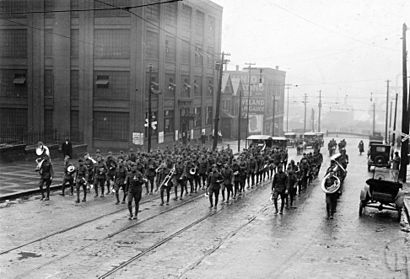May Day riots of 1919 facts for kids
Quick facts for kids Cleveland May Day riots |
||||
|---|---|---|---|---|
| Part of First Red Scare | ||||

Pershing's Band escort William Gibbs McAdoo from Union Station, Cleveland, May Day 1919
|
||||
| Date | May 1, 1919 | |||
| Location | ||||
| Parties to the civil conflict | ||||
|
||||
| Lead figures | ||||
|
||||
| Casualties | ||||
| Death(s) | 2 | |||
| Injuries | 40+ | |||
| Arrested | 116 | |||
The Cleveland May Day riots of 1919 were a series of violent events. They happened in Cleveland, Ohio on May 1, 1919. These riots took place during a May Day parade. The parade was organized by Socialist leader Charles Ruthenberg. Local trade unionists, socialists, communists, and the Industrial Workers of the World (IWW) joined the parade. They were protesting against the imprisonment of Eugene V. Debs. They also protested against American involvement in the Russian Civil War.
Contents
Why the Riots Started
The year before, Eugene Debs had a trial in Cleveland. Charles Ruthenberg's Socialist Party decided to hold a march. This march was meant to protest Debs' imprisonment. It also helped promote Ruthenberg's campaign to become Mayor of Cleveland.
The parade had 32 groups, split into four sections. Each section carried a Socialist flag and an American flag. The exact reason for the riots is debated. However, police and army members repeatedly told marchers to put down their flags. This demand reportedly became a major point of conflict.
What Happened During the Riots
As the marchers moved towards Cleveland's Public Square, one group was stopped. This happened on Superior Avenue. A group of Victory Liberty Loan workers stopped them. They demanded that the marchers lower their flags.
Soon after, an army lieutenant and his soldiers also told the marchers to get rid of their flags. When the marchers refused, the lieutenant ordered his soldiers to attack. A large fight started right away. More police were called, including mounted police on horses. They rode their horses into the crowd and hit people with their clubs. More than 20 marchers were badly hurt. Ambulances came from nearby hospitals to help the injured.
Second and Third Clashes
After the first riot calmed down, a second one began downtown. This happened at Public Square. Former Secretary of the Treasury William Gibbs McAdoo was giving a speech there. He was at a Victory Loan rally. An army lieutenant told socialists to leave the speaking area. He then ordered his men to attack anyone who did not obey. Mounted police with clubs and army tanks charged into the crowd. Seventy people were arrested and taken to the Central Police Station.
A third riot then broke out on Euclid Avenue. This was in the main shopping area. Later that evening, Ruthenberg's Socialist Party headquarters was attacked. Soldiers, police, and armed civilians ransacked the building. They "completely destroyed the building." Typewriters and office furniture were thrown into the street. By the end of the day, anti-socialists gathered many red flags and banners. They had taken these by force from the marchers. They piled them at the base of the Soldiers and Sailors' Monument in Public Square. Then they set them on fire in a huge bonfire.
After the Riots
The police used horses, army trucks, and tanks to respond to the protests. Two people were killed, and over 40 were injured. A total of 116 people were arrested. This included Charles Ruthenberg himself, who faced serious charges. Local newspapers quickly pointed out that only eight of those arrested were born in the United States.
After the riots, the city government quickly passed new laws. These laws restricted parades and the display of red flags. These events are seen as some of the most violent during the First Red Scare. This was a time when many people in the U.S. were worried about communism.
Different Views on the Events
The newspaper The New Solidarity, published by the IWW, offered a different view. They said that those celebrating May Day had not broken any city rules to cause a riot. They also stated that the mayor of Cleveland, Harry L. Davis, had told the police to stop any lawbreaking "promptly and firmly." This set the tone for how police would act.
The newspaper said that police and people who called themselves "patriots" caused a disturbance, not a riot. This disturbance was then used as an excuse for the police to step in. They used mounted police and German tanks, which were taken after World War I. These were used without care, even though women and children were present. The article suggested that the deaths and injuries were caused by police trying to break up the celebration. It also stated that 130 people were sentenced or fined.

